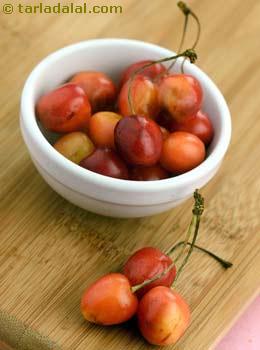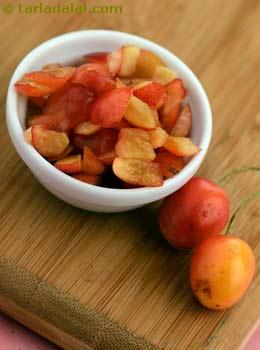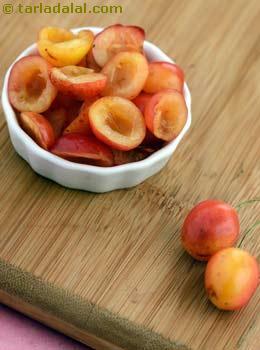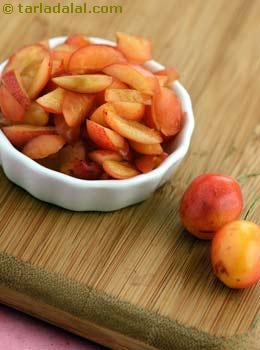cherries
Last Updated : Dec 15,2022
Cherry Glossary | Recipes with Cherry | Tarladalal.com
Viewed 24872 times

Also known as
Sakura
Description
The cherry is a small, round, dark-red fruit. It has a long stalk and a fleshy drupe containing a hard stony seed. Cherries grow on trees in small clusters, and can be classified into two main types: sweet and sour or tart.
• Sweet cherries are larger and heart-shaped. They can be enjoyed freshly picked and are also excellent when cooked. They range in colour from golden and red-blushed to dark red or purplish black.
• Sour cherries are smaller, softer and more globular in shape than sweet cherries. Unlike sweet cherries, most sour varieties are too tart to eat raw, but they are excellent in pies and preserves. Varieties of sour cherries range from bright red to dark mahogany.
Chopped cherries

Pit the cherries (remove the seeds) using a good cherry pitter. If you don’t have a pitter, start by slicing off the top to remove the stem using a sharp knife. Then cut it into half along the centre, and remove the seed. Now, chop the cherries by cutting them into small pieces approximately ¼ inch in diameter, although the chopped food doesn't need to be exactly the same size. Cut finely or into larger pieces depending on the recipe requirement.
Deseeded cherries

You can easily pit the cherries (remove the seeds) using a good cherry pitter. If you don’t have a pitter, start by slicing off the top to remove the stem using a sharp knife. Then cut it into half along the centre, and remove the seed.
Sliced cherries

Pit the cherries (remove the seeds) using a good cherry pitter. If you don’t have a pitter, start by slicing off the top to remove the stem using a sharp knife. Then cut it into half along the centre, and remove the seed. Now, slice by cutting vertically across the cutting board. Slice the cherries thinly or thickly as per the recipe requirement.
How to select
• Good cherries have bright, glossy, plump-looking surfaces and fresh-looking stems.
• Sweet cherries should be large, glossy, plump, hard, and dark-coloured, while sour cherries should be plump, firm, and a bright scarlet colour.
• In all varieties, the stems should be fresh and green, as dark stems are a sign of old age or poor storage conditions. Likewise, also avoid buying cherries that do not have stems.
• Never buy over-ripe cherries that are dull and shrivelled with dried stems, because they lack flavour. Test for the right stage by biting into a cherry – you should feel a crackle! If the cherries are too soft or feel flabby, avoid buying them.
Culinary Uses
• Cherries taste great when eaten plain. Rinse them under cold water, drain and serve fresh, with the stems attached for an attractive look. Some people prefer cherries chilled, while others find them sweetest at room temperature. Have it the way you like!
• Add cherries to a mixed fruit salad. Not only does it add a wonderful tangy flavour, it also imparts visual appeal.
• Cherries can be made into pie filling, flavoured yoghurt, jellies, jams, sauces, stewed fruit and fruit drinks.
• Blend fresh cherries into a smoothie, with yoghurt or ice-cream as the base.
• Use it to garnish desserts, cakes, ice cream and candies. After all, the proverbial cherry on the cake is as attractive as the jewel on the crown!
How to store
• Loosely pack unwashed cherries in plastic bags or place them in a shallow plate in a single layer and cover with plastic wrap.
• Store them in the refrigerator.
• Fresh cherries will last up to a week, but check them often and remove any that have gone bad as a number of spoiled cherries will start the others on the road to decay.
• To preserve cherries and use them later, select red, tree-ripened fruit. Remove the stems and rinse the fruit in cool water; remove pits, if desired. You can then freeze, can or dry the cherries.
Health Benefits
• Cherries contain no fat, cholesterol or sodium and can therefore be considered on a diet for a healthy heart.
• It is also a good source of fibre; so those suffering from diabetes and high cholesterol can safely have this fruit.
• A good source of vitamin C, it boosts immunity, helps fight infections and makes the skin shinier and healthier.
• Cherries contain beta carotene, a red coloured pigment that is a natural antioxidant for fighting cancer causing free radicals.

Soya

Missed out on our mailers?
Our mailers are now online!
View Mailer Archive
Privacy Policy: We never give away your email
REGISTER NOW If you are a new user.
Or Sign In here, if you are an existing member.

If your Gmail or Facebook email id is registered with Tarladalal.com, the accounts will be merged. If the respective id is not registered, a new Tarladalal.com account will be created.
Hi,

Click OK to sign out from tarladalal.
For security reasons (specially on shared computers), proceed to Google and sign out from your Google account.